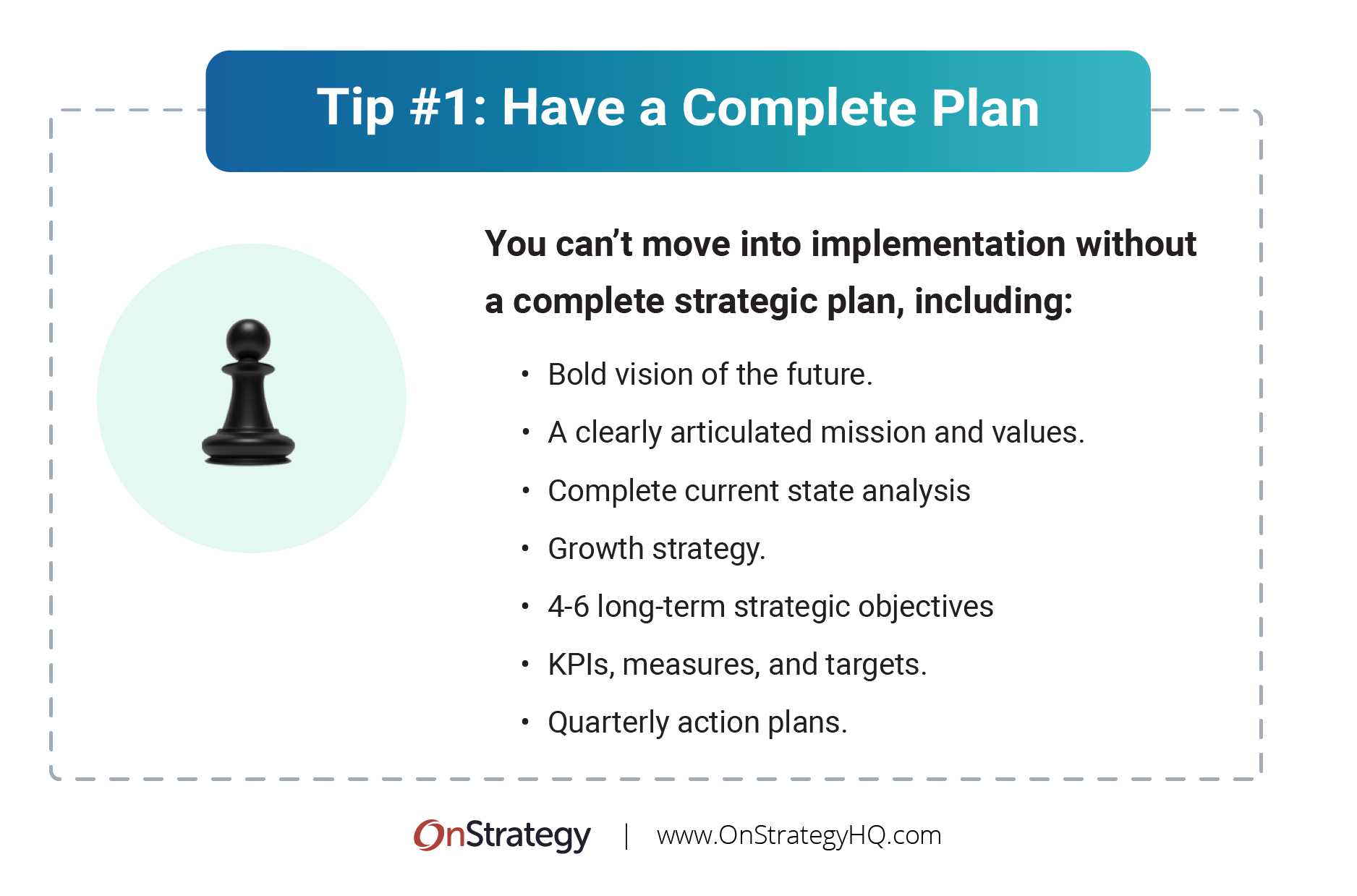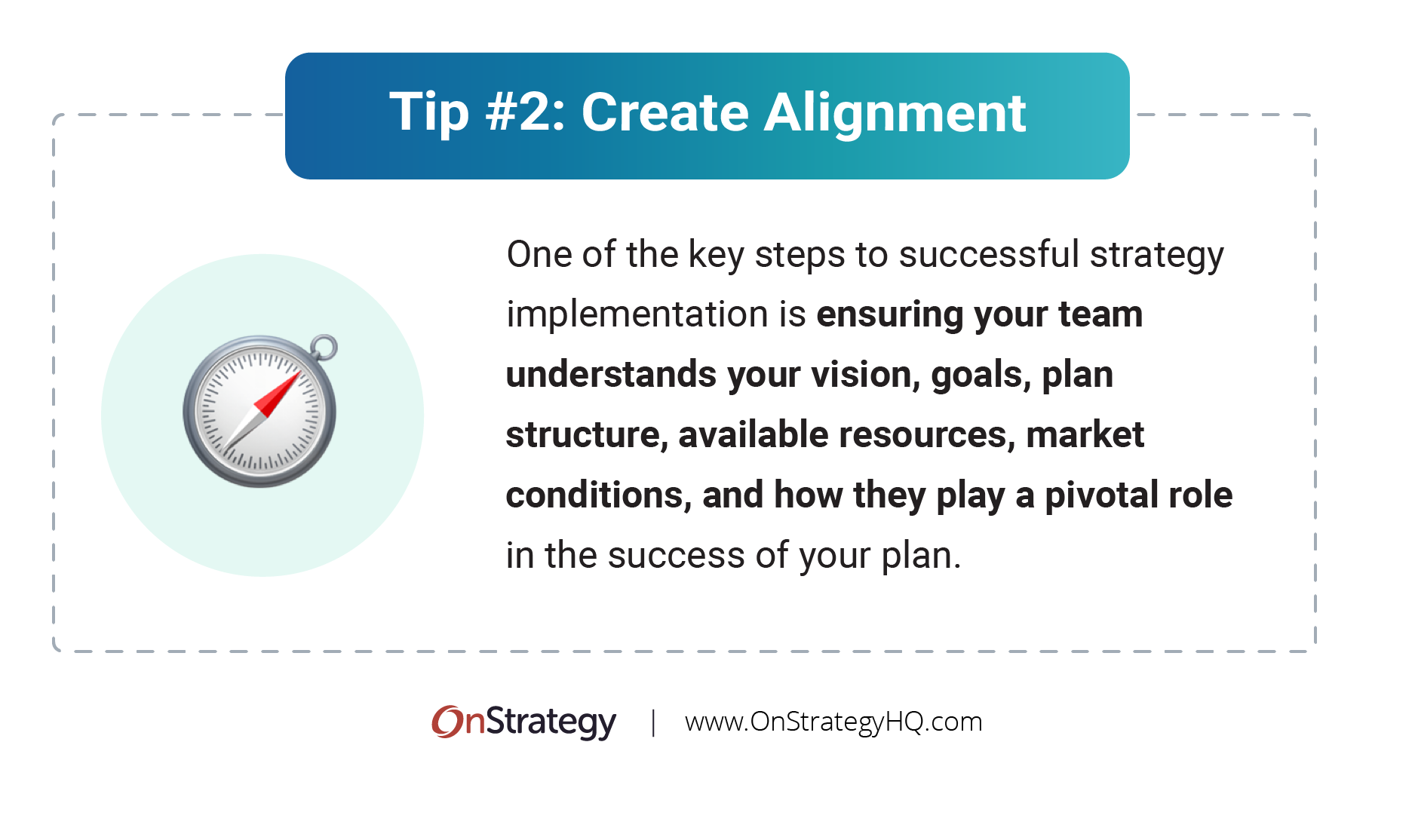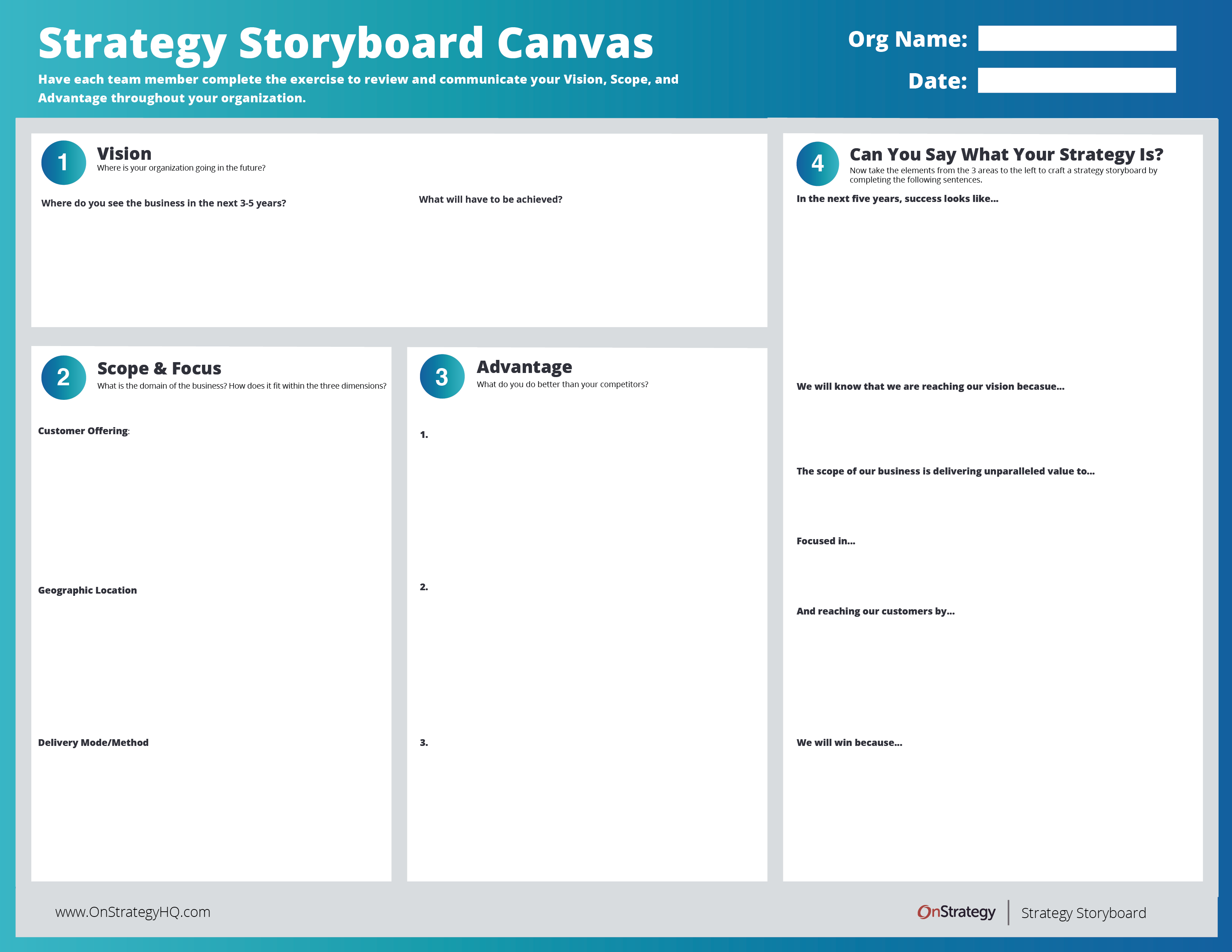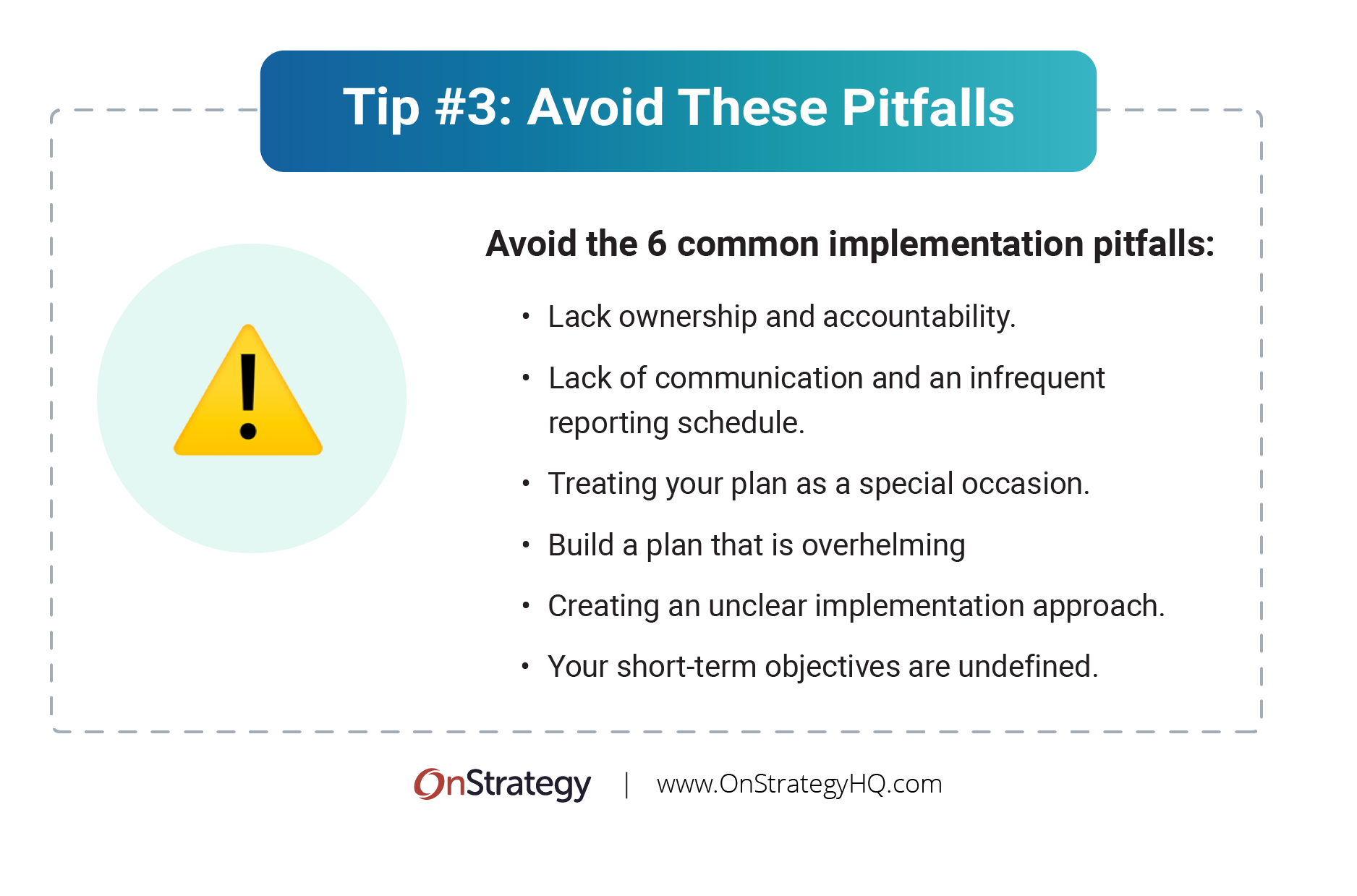What is Strategy Implementation?
Strategy implementation is the process that turns your strategy plan into real action. Implementing your strategic plan ensures your organization’s future growth and success. Effective strategic implementation involves several key components to support the successful execution of the strategy. We’re here to help you master bringing your strategy to life through a consistent, focused implementation process.
Is Implementing Strategy Difficult?
While strategy implementation is a critical follow-up for any new strategy or strategic plan, it poses significant challenges for many organizations. Nine out of 10 companies with strategic plans fail to implement them. Fortune Magazine says nine of ten organizations fail to implement their strategic plan. These reasons include:
- 60% of organizations don’t link strategy to budgeting
- 75% of organizations don’t link employee incentives to strategy
- 86% of business owners and managers spend less than one hour per month discussing strategy
- 95% of the typical workforce doesn’t understand their organization’s strategy.
Engaging key stakeholders in the strategic planning process is crucial to ensure alignment and buy-in from various organization leaders. Validating strategic goals with both internal teams and external key stakeholders helps guide and shape the organization’s strategic decisions.
The root cause of strategic implementation failure often lies in lacking a well-defined, actionable plan that resonates with the organization’s broader goals.
3 Pro Tips for Strategy Implementation

Tip 1: Have a Complete Plan
This might seem obvious, but the first step is ensuring an implementation-ready plan before starting your implementation process. A great plan covers what you want to achieve and why you’re setting out in this direction.
It’s supported by clear objectives, goals, and actions that articulate who, where, when, and how you’ll achieve your bigger vision of success. Additionally, having essential components and systems in place is crucial for successful strategy execution, as they support effective implementation by providing necessary processes, procedures, and tools for monitoring and evaluating performance.
Before moving into a strategy implementation and execution process, make sure your strategic plan checks off the following boxes:
- You have a clear vision of the future.
- Your plan articulates your mission and core values.
- You have a current state analysis that articulates where you are today.
- A clear growth strategy has been defined and is supported by your competitive advantages.
- There are 4-6 long-term strategic objectives that create the framework for your plan.
- You have annual goals/OKRs to support your long-term objectives.
- You have clear KPIs, measures, and targets.
- You have the right people in the room.
- You have a quarterly action plan.
Ensuring that your strategic plan is ready to implement requires getting your teams together, outlining expectations, assigning roles and responsibilities, setting deadlines and KPIs, and finally, providing the resources needed for your teams to do their jobs to bring your strategic plan to life.

Tip 2: Ensure Your Stakeholders and Team are Aligned
One key step to successful strategy implementation is ensuring your team understands your vision, goals, plan structure, available resources, and market conditions and how they play a pivotal role in the success of your plan.
You’ll be stuck before you start without alignment and buy-in to your plan and process. In a best-case scenario, this should have already been established during your strategic planning process, but it is good to summarize and re-iterate these points for your team early. This strategy storyboard exercise can help your team contact your plan again. Once your team is aligned on your goals and objectives and understands your strategy, it is time to implement your strategic plan.
Once your team is aligned on your goals and objectives and they understand your strategy, it is time to implement your strategic plan.

Tip 3: Recognize the Pitfalls in the Implementation of Strategy. Avoid Them.
Identifying and course-correcting your pitfalls before they occur is a more beneficial and mature approach to strategic implementation, especially in the beginning stages or if this is your first strategic planning process.

6 Strategic implementation roadblocks and OnStrategy’s best practices to avoid them:
Because you want your plan to succeed, heed the advice here and identify the pitfalls and solutions that are most relevant to your strategy implementation process. Here are the 6 most common pitfalls seen in strategic plans and how you can avoid them as you implement your strategy:
Lack of Ownership and Accountability
Lack of ownership is the most common reason a process fails. If your team members don’t have a stake in the plan, it’ll be business as usual for all but a frustrated few. This lack of ownership also coincides with a lack of accountability, where your team is unwilling or unable to take responsibility for the plan’s success.
OnStrategy Approach: We recommend employing cross-functional teams so everyone is responsible for a piece of the plan. Accountability helps drive change, so each measure, objective, data source, and initiative must have an owner.
Lack of Communication and Infrequent Reporting
Your plan doesn’t get communicated to employees, and they don’t understand how they connect with the strategy or contribute to its success. Your team also doesn’t find value in frequent reporting, so meetings are regularly pushed back in favor of higher-priority tasks.
OnStrategy Approach: The solution to this pitfall is ensuring that your entire organization and each relevant team are in alignment and clearly understand the strategic plan and their role within it. This means regular, firmly scheduled check-ins to report on progress and address shortcomings. These meetings should be treated just as important as any other.
Treating Planning as a Special Occasion
This can hinder your plan’s effectiveness. When strategic planning is viewed as separate from the day-to-day management process or only addressed during annual retreats or special events, the overall impact of your strategy diminishes.
OnStrategy Approach: To counter this, integrate your strategy into the core of your organization’s operations through consistent reporting and ongoing activity (monthly reporting and quarterly refresh). Rather than treating strategy as a periodic project, make it an integral part of everyone’s regular responsibilities and job duties.
Your Plan is Overwhelming
The goals and actions generated in the strategic planning session are too numerous because the team failed to make tough choices to eliminate non-critical actions. Employees don’t know where to begin.
OnStrategy Approach: We always recommend that organizations focus on 4-6 key initiatives or objectives within their strategic implementation plan. This ensures your team isn’t spread too thin and that you are only focusing on the relevant and impactful initiatives that will drive your success.
Your Strategic Implementation Plan Lacks Clarity
Implementation isn’t discussed in the strategic planning process. The planning document is seen as an end in itself, but you lack the forethought on how to make it actionable.
OnStrategy Approach: The objective of strategic planning is not just the plan itself but the continual process of working towards it and improving it. You need to set clear, actionable steps to make your strategic plan more than just a sheet of paper—this means setting KPIs, scheduling regular check-ins, assigning teams and goal owners, and implementing strategy via tracking and communication processes so that everyone is on the same page.
Your Short-term Objectives are Undefined.
Another reason why your team may struggle to implement strategy is due to a lack of clear objectives. Sure, the broad strokes of your plan and vision are outlined, but you lack the key components of a complete plan, including annual goals, quarterly action plans, and key performance indicators.
OnStrategy Approach: Make sure you have a complete plan and roadmap for achieving your business goals. Your long-term plan must be supported by short-term goals and objectives with measurable analytics! A purpose-built strategic management tool and dashboard can also help keep our team coordinated and aligned. Again, with the help of a dynamic dashboard, like as the StrategyHub, you can set clear goals with well-defined measurements of success. Setting smaller, specific objectives that you know will contribute to your long-term goals will allow you to see in real-time what is working for your plan and what is not working and allow you to re-calibrate accordingly.
It’s easier to avoid pitfalls when they’re clearly identified and when you’ve outlined a solution to address them. Now that you know what they are, you’re more likely to jump right over them!
To Implement Strategy, You Need a Consistent Process
Adopting a consistent implementation approach is the most important action you can take to align your team members, stakeholders, executive team, and board.
An implementation strategy with clarity and consistency looks something like this:
- A clearly implementation calendar and scheduled reviews.When you roll out your plan, schedule your monthly and quarterly reviews out for the year. It can be helpful to include monthly updates in your current standing meetings, but you should host dedicated quarterly reviews to review performance, refresh your plan, and create a focus for the next quarter.
- Clear expectations for when performance is to be updated and reviewed. Your entire team members need to know what they own and when they are responsible for updating their progress against performance.
- Resource allocation and how your team uses their time. Clarify what resources your organization is using to execute your plan and how you need your organization to use their individual time and resources to achieve your bigger goals and actions. If your team needs additional resources, give them a forum to ask for them!
- A consistent and effective communication. Successful implementation relies on your organization having the means to communicate its progress and what it needs to support achieving its goals.
9 Steps to Finalize a Strategy Implementation Approach
Implementing your plan includes several steps and can sometimes feel like it needs another plan of its own. But you don’t need to go to that extent. Use the steps below as your base implementation plan. Modify it to make it your own timeline and fit your organization’s culture and structure.
- Finalize your strategic plan after obtaining input from all invested parties.
- Align your budget to annual goals based on your financial assessment.
- Produce the various versions of your plan for each group.
- Establish your scorecard system for tracking and monitoring your plan.
- Establish your performance management and reward system.
- Roll out your plan to the whole organization to implement the strategy.
- Build all department annual plans around the corporate plan.
- Set up monthly strategy meetings with established reporting to monitor your progress.
- Set up annual strategic review dates, including new assessments and a large group meeting for an annual plan review.
Strategy Implementation Doesn’t Need to Be Overwhelming!
Setting your strategy implementation approach might seem totally overwhelming after you complete your plan, but it doesn’t need to be. If you need help, we’ve got you covered with our expert strategy consultants and purpose-built strategy implementation tool called the StrategyHub.
We can help you ensure your plan is supported by the organizational culture, implementation approach, and necessary resources to achieve your vision of success.
Covering All Your Bases
As a business owner, executive, or department manager, your job entails making sure you’re set up for a successful implementation. Before you start this process, evaluate your strategic plan and how you may implement it by answering a few questions to keep yourself in check.
Honestly answer the following questions:
- How committed are you to implementing the plan to move your company forward?
- How do you plan to communicate the plan throughout the company?
- Are there sufficient people who have a buy-in to drive the plan forward?
- How are you going to motivate your people?
- Have you identified internal processes that are key to driving the plan forward?
- Are you going to commit money, resources, and time to support the plan?
- What are the roadblocks to implementing and supporting the plan?
- How will you take available resources and achieve maximum results with them?
Checklist for a complete plan before moving into implementation:
- You have a clear vision of the future.
- Your plan articulates your mission and core values.
- You have a current state analysis that articulates where you are today.
- A clear growth strategy has been defined and is supported by your competitive advantages.
- There are 4-6 long-term strategic objectives that create the framework for your plan.
- You have annual goals/OKRs to support your long-term objectives.
- You have clear KPIs, measures, and targets.
- You have the right people in the room.
- You have a quarterly action plan.













Hi i like to read these article and i got lots of help about strategy plan thanks
the implementation plans can assists an organisation in making its strategic efficiently which bust the organisation performance
Great article , I am an MBA student from kenya and am intending to research on factors that influence the implementaton of strategic plans in kenyan schools .
Any idea on the relevant objectives and theories for my theoretical review and framework will be highly appreciated .
The article has been of invaluable use to me.thanks a lot.I would like to get more articles on strategic Management since I have done an Undergraduate degree in Strategic Management.
Good outline. My experience suggests that strategic plan ACHIEVEMENT always boils down to: broad understanding; assignability; actionable tasks; measurable elements; and stretch reasonableness. When plans fail, it’s usually because they’re either too esoteric, vague, unrealistic, or lack broad-based employee buy-in. Shorter-term plans, subsidiary plans, budgets, functional assignments, and job descriptions need to support this broader set of goals and objectives. There needs to be regular, ongoing communication and updates. Lastly, (and this makes professional planners uneasy), it’s not just about an elegant process, it’s about translating that vision into an executable framework from which elegant outcomes are actually achieved.
this is great and I have scooped a lot from it
Thanks a lot.This article has made me understand better
Isn’t this from “Strategic planning for dummies”? anyways thanks
Hi Brian- Our COO, Erica Olsen, wrote the book “Strategic Planning for Dummies” so you will some very similar thoughts here that you would see in the book.
thanks for the article . it has really helped me answer all my questions keep it up.
Thanks but can you assist more on why in most cases the strategic planning is regarded as a meaningless ,trivial and mundane ritual in organisations
I’m very happy reading your article and help much in our project implementaion, hoping that there are still more than this, thanks very much
The article is very useful for information. Thank you.
thanks alot for the outline,really impressed though an advise for strategy formulation in a motor vehicle showroom as a new business venture and also implementation of the same.
This is a very valuable piece. You helped me understand strategic planning and implementation much better. Thanks so much.
Very helpful information, thank you!